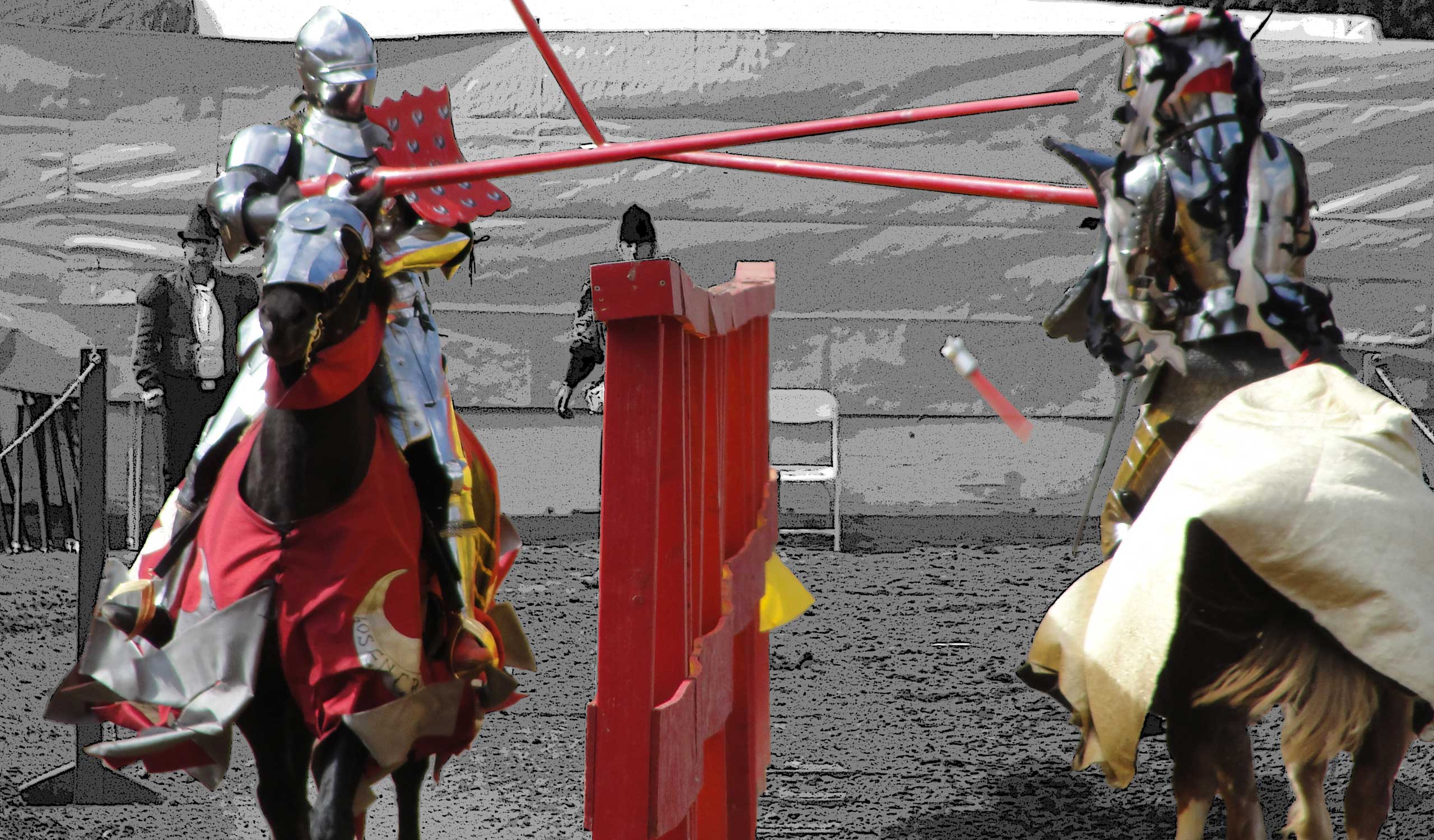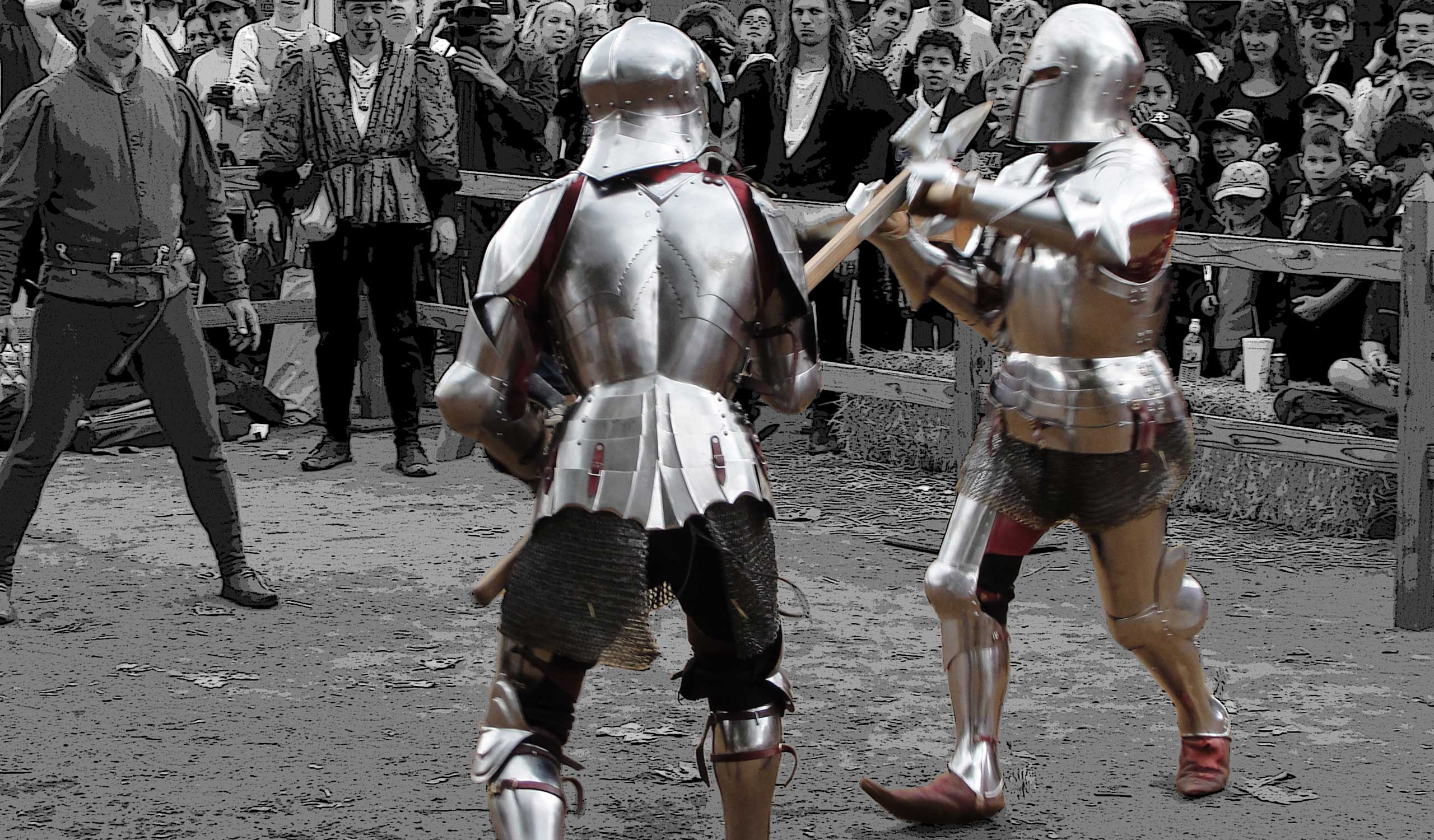
 nyghtly Armes is dedicated to bringing the fifteenth century back to life. Our mission is to promote a greater understanding of knightly martial arts through the authentic display of late medieval arms, armour and accoutrements in public pageants, mounted tournaments and chivalric duels.
nyghtly Armes is dedicated to bringing the fifteenth century back to life. Our mission is to promote a greater understanding of knightly martial arts through the authentic display of late medieval arms, armour and accoutrements in public pageants, mounted tournaments and chivalric duels.
Knyghtly Armes can provide interactive, educational demonstrations for schools and organizations, making history both engaging and entertaining to people of all ages. We strive to recreate the past as realistically and faithfully as possible, thereby erasing many previously-held misconceptions long perpetrated by American television, cinema and popular culture. We carefully choose our clothing and equipment to be as close as possible to the originals. In the end, we hope to cultivate an appreciation of the medieval knight in the next generation.
Over the last few years, Knyghtly Armes members have been fortunate enough to view some of the finest medieval collections in Europe including the Wallace Collection in London, Royal Armouries in Leeds, Musée de l'Armée in Paris, Legermuseum in Delft, La Real Armería in Madrid and, most recently, the Welt Museum in Vienna. Visitors to the Knyghtly Armes site are permitted to view and reproduce digital images from our ever-growing resource collection without notice. Alternatively, you may visit our Facebook page to browse our arms and armour photo albums. Simply give us a ”like" if you find them beneficial.
Library
We are pleased to provide an ever-growing collection of arms and armour photographs as a non-commercial resource to students of medieval history. Collections include the Wallace Collection, Royal Armouries in Leeds, Musée de l'Armée, Legermuseum, and, most recently, the Welt Museum in Vienna.
Knyghtly Armes answers the question...
- How much did armour cost?
- Was armour only for knights?
- Did armour really shine?
- Where was armour bought?
- Do you have questions?
-
Q: How much did armour cost?
A: There are a number of contemporary sources that may be referenced in order to get an accurate idea of the cost of armour during the fourteenth and fifteenth centuries. The chief source of income for nobles and gentry was through the collection of rents and taxes. Every landowner worth his salt had at least one clerk on his payroll, and professional clerks are, obviously, very meticulous record keepers. There are extant documents that detail the amounts of rent collected from various tenants, inventories of individual estates and manors, and salaries of individual servants and retainers ...
FIND OUT MORE -
Q: Was armour only worn by the knightly class?
A: In late Medieval Europe, various kinds of armour would have been widely seen and used by all classes of society By law, every able-bodied freeman in England was expected to be "well and defensibly arrayed" as befitting his status in the event of war. For many, that body armour might only be a padded jack--a quilted coat made of between 15 and 20 layers of linen--sewn by his wife or mother. For a few shillings more, a man might acquire a crude sallet to protect his head, mitten gauntlets over the hands, and maybe even protective pieces on the arms and/or legs made from boiled leather, or "cuir boulli".
FIND OUT MORE -
Q: Did a knight's armour really shine?
A: Many of the armours made in bulk to be sold "off the rack" would have been left unpolished in order to reduce the cost. One as to remember that these armours were created in an age before the high-powered electric buffer wheels. Today, almost everything constructed of metal is highly polished. During the Middle Ages, it was much less common. It required significant time and energy to grind and polish a satin sheen on hammered steel. According to Tobias Capwell, curator of Arms and Armour at the Wallace Collection in London, that additional work could account to as much as 80% of the cost of a suit of armour.
FIND OUT MORE -
Q: Where did a knight buy his armour?
A:Similar to buying a suit today, there were a number of options depending on he amount of silver a knight was looking to spend. Some gentry were more "landed" than others Those on the lower spectrum were forced to buy "off the rack" from merchant armourers. More merchant-middlemen than armourer, these businessmen essentially bought armour from distant manufacturers in bulk and re-sold it to their local clients.
FIND OUT MORE -
Q: Do you have a question you want answered?
A: Check out the site's Question & Answer section. If you cannot find the answer there, use the Contact Form to submit your question. Knyghtly Armes will do its best to provide you with a prompt answer or refer you to someone who can.
FIND OUT MORE

"Young man, now learn to love God and honor women, speak well of women and be brave, as one should be, guard yourself from lies and deceit. Strive after integrity and take great pains in your knightly practices: throwing and pushing stones, dancing and jumping, fencing and wrestling, running at the lance and tournaments, and courting beautiful women."

To promote a greater understanding of fifteenth-century equestrian martial arts through the authentic display of knightly arms, armour and accoutrements.











